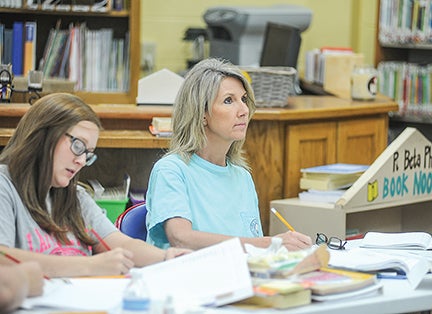Teachers learn to improve student reading skills
Published 12:00 pm Tuesday, June 7, 2016

- Bruce Newman Sandy Brown and other teachers attend a teacher workshop at Lafayette Elementary School on Monday.
By Michael Quirk
michael.quirk@oxfordeagle.com
The tables have turned as a group of Lafayette Elementary School teachers are taking to the desks for a summer school course. It’s not because they’re behind in coursework, it is to get ahead.
Each of the school’s first- grade and a handful of kindergarten and second-grade teachers are taking direction from Anna Shinnick of Spalding Education International on a two-week course designed to improve students’ reading skills.
“It’s a teacher improvement program for strategies for teaching teachers of integrated language arts to teach spelling, reading and writing to students in the classroom,” Shinnick said. “Giving them the strategies to be successful in their spelling, reading and writing.”
The Spalding Method has been around for a half-century, and integrates multi-sensory etching that the teachers begin with the teaching of phonemic awareness in kindergarten. Then the students begin with the sounds of phonograms, learning how to count and blending them in order to recognize those sounds in words.
First-grade teachers then continue the direct sequential learning as it progresses throughout the grade levels. LES Principal Paula Gibbs has taught the method for 25 years, first learning it in south Louisiana.
While some teaching strategies become fads, Gibbs said the Spalding method stayed true because of the consistency of the language.
“It’s true to form, it works on the basic teaching of reading through phonetics,” she said. “Its roots began with students with dyslexia, they focused on those children’s learning styles and thought ‘gosh if we do that we everyone in the room, imagine the gains they’d have in reading.’”
The teachers were given basic instruction on the method last summer from Gibbs before the course with Shinnick this year. Some of the things that stuck out to the teachers include making letters using a clock face starting at2:00, spacing, and forming sounds correctly. First grade teacher Leslie Butts said it was an old school strategy that caught her attention.
“I’ve been teaching for 13 years and it’s interesting to see the handwriting perspective coming back into play,” Butts said. “It’s important the children know how to form the letters and connect the writing and reading, making all those connections. It’s something that’s come back around.”
Gibbs praised her teachers for giving time from their summers to learn the methods, and their commitment over the last school year in implementing it.
“It’s phenomenal for the children, just phenomenal for the kids.”





